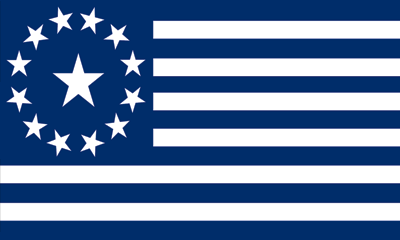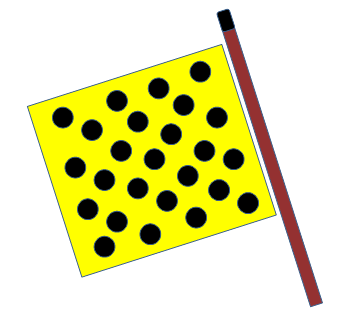The Ensign Peak Flag
 Ensign Peak State Park Entrance Ensign Peak figures prominently in the history of the Mormon settlement of the Salt Lake Valley. The Mormon Pioneers saw their migration as fulfilling Biblical prophecy. Isaiah records many verses describing the raising of an ensign in the tops of the mountains as a signal for the "outcasts of Israel to gather." The journals of several Mormon Pioneer leaders mention this idea. When they climbed a small mountain peak located just north of Salt Lake City only two days after their arrival in the Great Basin, the men named it Ensign Peak noting that it would be a good place to raise an ensign. However, the record indicates that they did not have a flag with them on that date. Talk of raising a flag on Ensign Peak was common in 19th Century Utah, but historians have found no record of an official raising of an ensign by the LDS Church authorities.
The Kimball/Maguire Flag

This reconstructed flag is named the Kimball/Maguire Flag because an early territorial trader named Don Maguire claimed he saw it displayed from a second story window in the home of the late Heber C. Kimball. The story goes that on September 2, 1877, the day of Brigham Young’s funeral, Don Maguire saw this flag at the residence of Kimball, who had been a close advisor of Brigham Young. The Kimball home was located on Main Street, a block north of the Temple Block, where Young’s funeral was held in the Tabernacle. Maguire was a non-Mormon who traveled to Salt Lake when Brigham Young died to make sure, as he said, that "the old devil was dead." Maguire had no connection with the LDS Church leaders, but he concluded that it was the flag that Brigham Young and associates had raised on Ensign Peak on July 26, 1847. By 1877 it was already firmly believed that Young had raised a flag on Ensign Peak on his first visit there on July 26, 1847. While some maintained it was a US flag, others insisted it was a religious flag of the Mormon Pioneers called the "Ensign of the Nations" - this new "urban" legend was already firmly seated in tradition. That Maguire, himself, made such a highly speculative assertion that the flag he saw was the very one one flown from Ensign Hill should not surprise anyone, because Maguire also believed that the ruins of a great Aztec city would be found in the Salt Desert west of the Great Salt Lake, and other such nonsense. His judgment might be considered a bit questionable.
Maguire also jumped to the conclusion that the flag was taken down to be buried with Brigham Young. He observed the flag in the morning, but it was taken down by the afternoon. The record does not support his guess. This assumption was just another case of Don Maguire explaining things about which he knew nothing.
Kimball´s Polka-Dot Bandana

A possible signal from the Peak?
In recent years another new "urban" legend has developed that claims the item flown on Ensign Peak was a yellow handkerchief with black spots owned by Heber Kimball. According to this story, the bandana was tied to a cane and waved from the top of the hill, but the journals of the participants that day do not mention it or give it any significance. It was only William C.A. Smoot, then an eighteen year old boy, who claimed to have observe it from below and wondered about its significance; no one else in the pioneer party even mentioned it. It is possible that somebody in the group did wave a bandana tied to a cane from the top of Ensign Peak that day, but it was doubtful that it was intended to be a flag or ensign. It was more likely only a signal of greeting to the camp below.
Other Possible Ensign Hill flags
|
|
|
A 26-Star US Flag possibly was carried by
the Mormon Battalion "Pueblo" Detachment |
|
A 13-Star US Flag possibly used by Young,
according to Brigham Young family tradition |
Two other candidates for the first flag to be flown from Ensign Hill include a United States Flag possibly raised there by the Mormon Battalion Pueblo Detachment on their arrival at Salt Lake City, or a personal 13-Star Flag belonging to Brigham Young.
During the famous march to California of the Mormon Battalion (later see Mormon Battalion Flag) some of the wives and children accompanying them separated from the main group, together with sick member of the Battalion, and were sent north to Pueblo and Bent's Fort. They wintered there, were resupplied, and then continued on to the Great Salt Lake Valley to join the other settlers. This detachment arrived in Great Salt Lake City on July 29, 1847. (Actually only five wives and a few children actually made the entire march to San Diego with the Mormon Battalion, where they cooked and did laundry for the soldiers.) At Salt Lake City the "Pueblo Detachment" joined the Pioneer Company there to help settle the area.
George A. Smith recounted that the Pueblo Detachment marched into the Salt Lake Valley "all armed and carrying the flag of the United States." However, he does not describe which flag. It could have been either a 26, 27 or even 28 star flag, but wasn't necessarily any of them.
If the U.S. Army issued flags to the Mormon Battalion and its Pueblo Detachment, they could have been 26, 27 or 28 star flags. The Battalion arrived at Fort Leavenworth to draw equipment and supplies on August 1, 1846. If they were given the correct flag for that date, it would have been the 28 star flag. However, since that flag only became official on July 4th of 1846, it is likely that the fort would have had a store of older 27 or 26 star flags. The Battalion generally drew older equipment with newer equipment going to the regular army. (One historian claims that the volunteers outfitted at Fort Leavenworth were given flags with empty blue unions displaying no stars. They also received a can of paint and an artist´s brush to add stars for themselves.) The Pueblo Detachment may also have obtained their flag at Bents Fort, or they may have made a flag while wintering there.
In May of 1928, the Brigham Young family association held a reunion where they raised a flag that they claimed was the first flag Young raised in the Salt Lake Valley. The rumor that it had been buried with Young was another Don Maguire concoction. A picture of that flag appeared in a newspaper published at the time. The flag that the Young Family Association had in 1928 may have also been the flag the Pueblo Detachment carried into the Valley on July 29, 1847, and then displayed on Ensign Peak in late July or in August of 1847. The record only gives us clues and does not spell out details with any certainty.
In conclusion, all one can say is, that historically, it seems fairly certain that no flag was even carried by the first Mormon party to visit the future home of Salt Lake City (at the time still part of Mexico), and certainly no flag was flown from Ensign Peak as legends attempt to suggest on that first visit on July 26, 1847. When a flag was finally flown from the Peak, and what flag it might have been, is still up for debate. Although either a 26 or 27 star US Flag is the most likely candidate, it could have also been the 13 star flag the Brigham Young family had in 1928, since thirteen star flags were also commonly flown in the mid-19th century Western United States. Basically, the more stars on a flag, the harder the flag is to make.
|